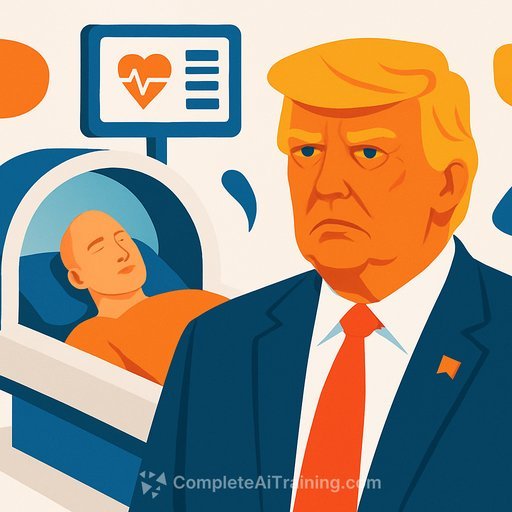AI "Medbed" Video: What Clinicians Need To Know Now
Over the weekend, President Donald Trump posted - then deleted - a fake Fox News clip showing him in the Oval Office announcing a nationwide rollout of "medbeds." The video, which appeared to be AI-generated, featured Lara Trump introducing "medbed cards" for use at "medbed hospitals." It promised guaranteed access and full restoration of health. The beds do not exist.
The White House has not explained why this claim was posted. The clip fed a long-running internet myth about a magical device that heals any illness, regrows limbs, or reverses aging. For healthcare teams, this is a near-term patient counseling problem, not a future tech breakthrough.
What "Medbeds" Are - And Are Not
"Medbeds" are a conspiracy theory popular in fringe communities like QAnon. Believers say the devices are real, reserved for elites, and sometimes claim they came from military or alien technology. There is no credible clinical evidence, no peer-reviewed data, and no regulatory approval for any device that matches these claims.
- Common promises: cure any disease, reverse aging, regrow limbs.
- Common narratives: secret tech, global gatekeeping, imminent rollout.
- Common channels: TikTok, Facebook groups, Telegram, alternative-medicine forums.
Commercial Spin-offs Patients May Encounter
In the vacuum created by the viral claim, a few companies sell "medbed" experiences. One example markets "cellular recharge sessions" for about $120 and at-home blocks for thousands of dollars that purportedly emit "life force" or "biophoton" energy. A BBC reporter described receiving a session in a motel room and left unconvinced by the experience.
These offers rely on vague language, personal anecdotes, and pay-to-feel-better framing. No independently verified clinical outcomes. No transparent protocols. No data you can reproduce.
Why This Matters For Clinical Practice
- Delayed care: Patients may postpone proven treatments while chasing a miracle device.
- Financial harm: Families can spend thousands on unproven sessions and devices.
- Erosion of trust: Viral deepfakes blur the line between public health messaging and fiction.
Red Flags To Share With Patients
- "Cures everything" or "guaranteed results."
- Claims of secret tech, elite access, or alien/military origin.
- No published trials, no independent replication, no oversight.
- Sessions offered in nonclinical settings (e.g., motel rooms).
- High upfront cost, pressure to book, testimonial-driven marketing.
How To Respond In Clinic
- Lead with empathy: "I see why that sounds hopeful. Let's review what we can verify."
- Ground in evidence: Explain the standard of proof (randomized trials, peer review, safety data).
- Offer safer alternatives: Align proven options with the patient's goals and values.
- Share trusted resources on health fraud and false cures: FDA: Health Fraud Scams.
- Build literacy on AI fakes: Teach simple checks (source verification, reverse image search, audio artifacts). See CISA guidance on deepfakes.
- Document conversations and risks if refusal of care is influenced by misinformation.
Talking Points You Can Use Today
- "There is no verified device that can restore every person to full health. If one existed, we would see published trials and regulatory approval."
- "Extraordinary claims require transparent data. Testimonials and viral videos are not evidence."
- "If you're interested, we can review credible trials for therapies that match your goals."
Policy Context
The clip's claim of government-run "medbed hospitals" is fictional. The episode lands in a climate where skepticism of mainstream medicine remains high and conspiracy content spreads fast. The original report also notes that promising research has faced significant cuts in the current administration, raising concern about the future pipeline of real therapies.
Bottom Line For Healthcare Teams
There are no medbeds. Treat this as a patient safety issue: correct the record, protect against financial and clinical harm, and keep patients engaged with proven care. Build simple scripts, share trusted resources, and train your team to spot AI-generated misinformation.
Optional resource for team upskilling: Short, practical AI literacy modules can help staff spot deepfakes and coach patients. See AI courses by job role.
Your membership also unlocks:






